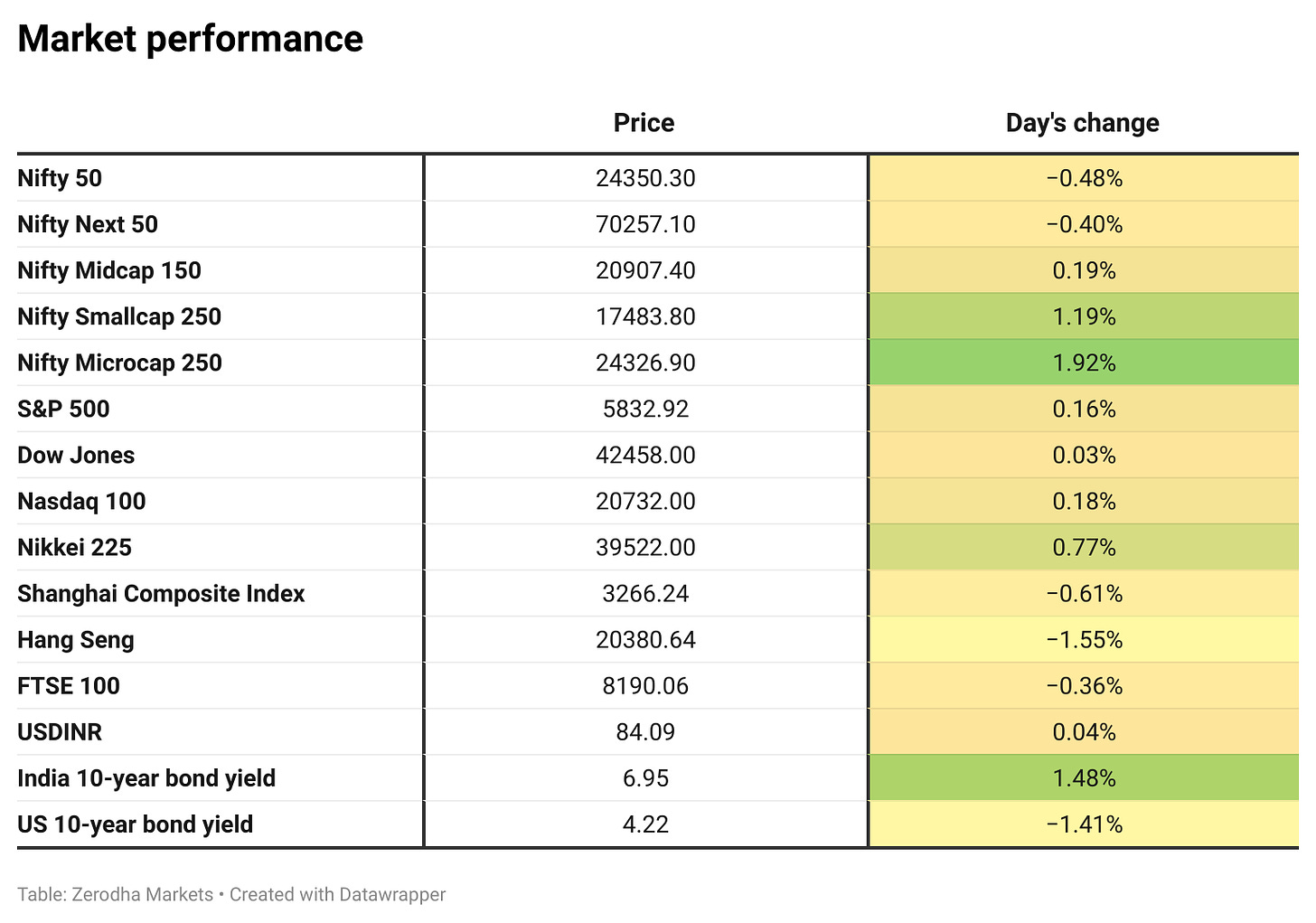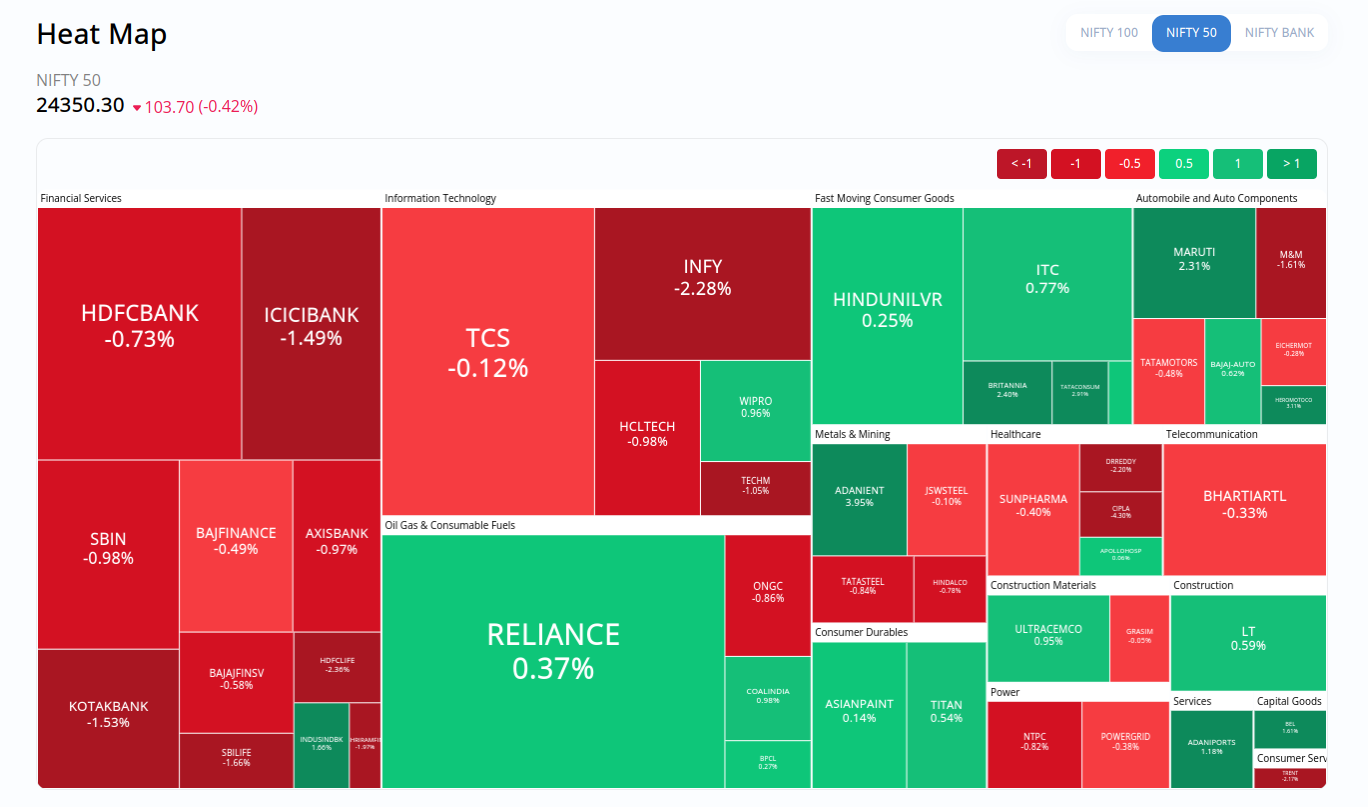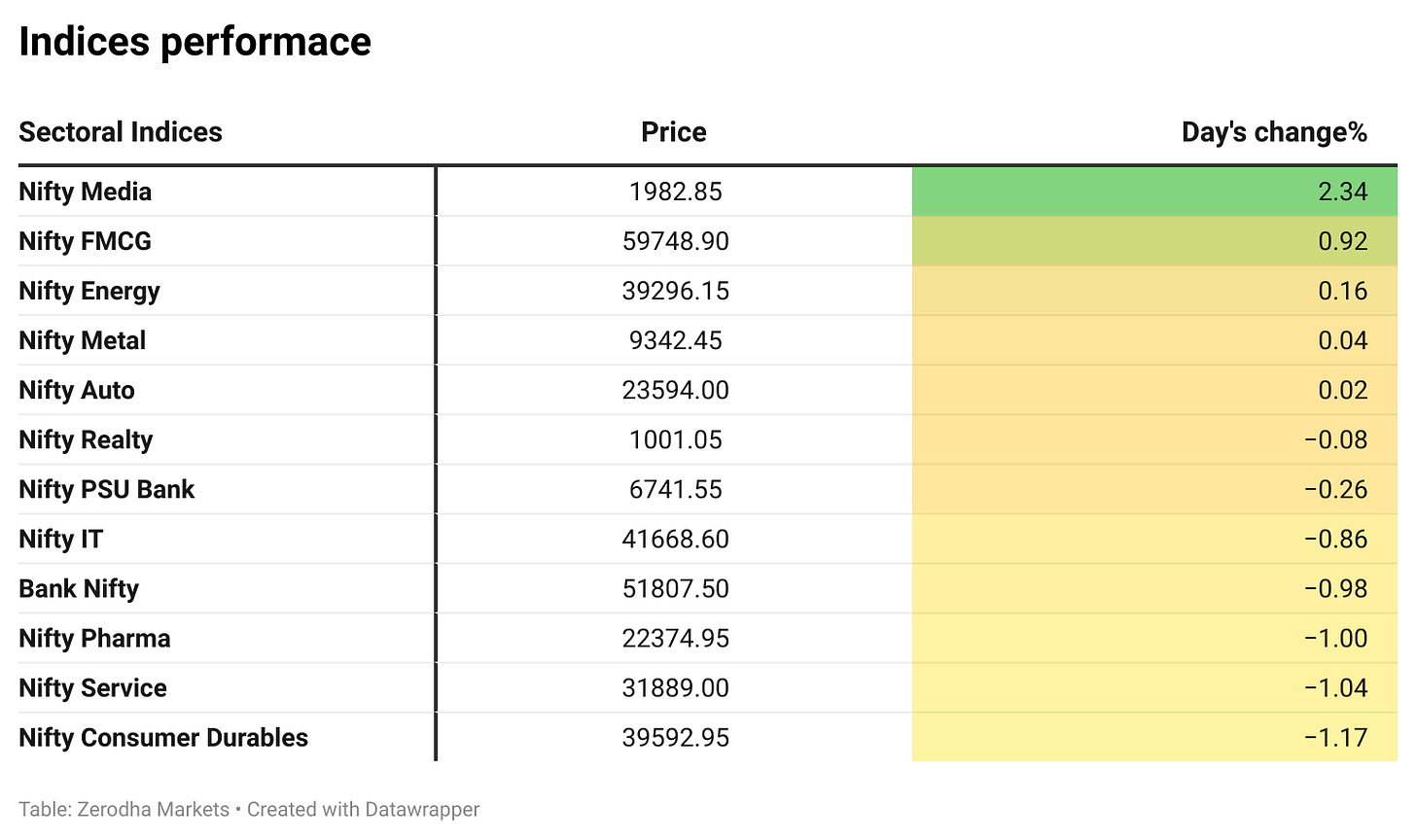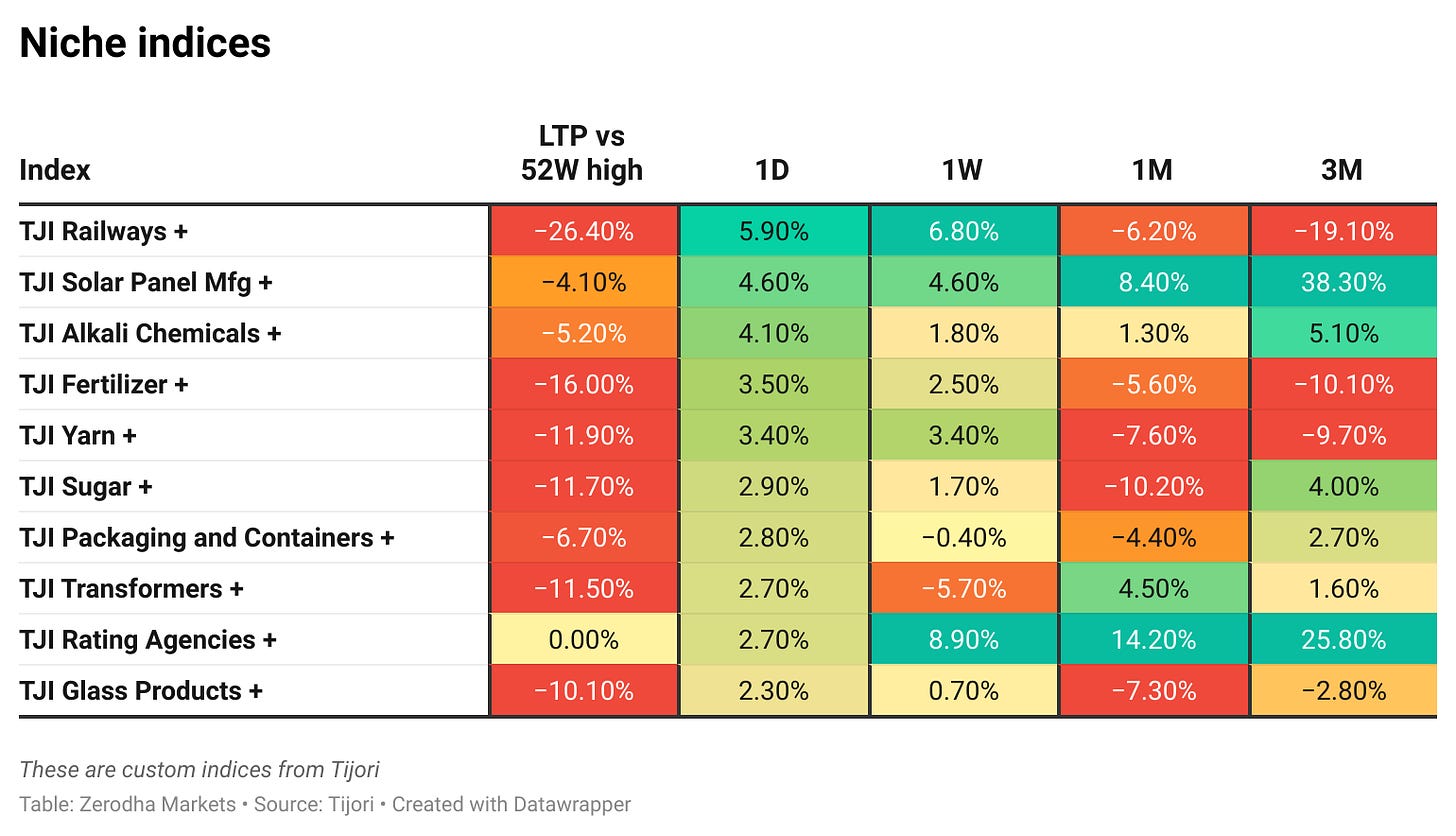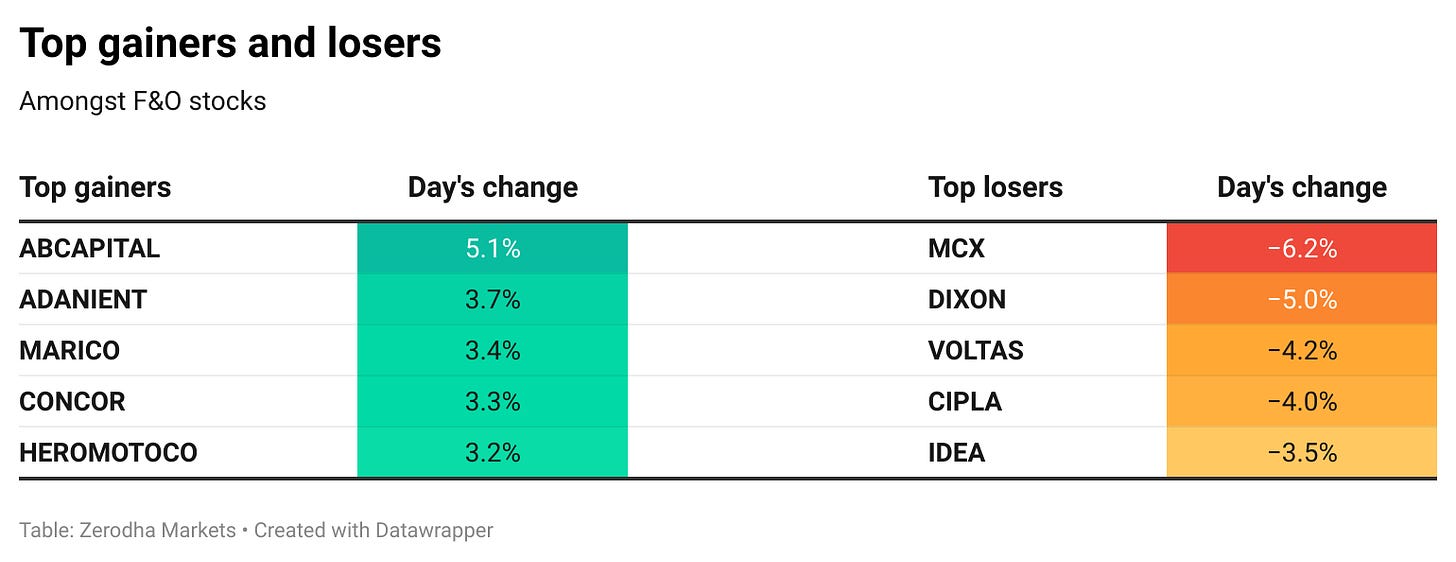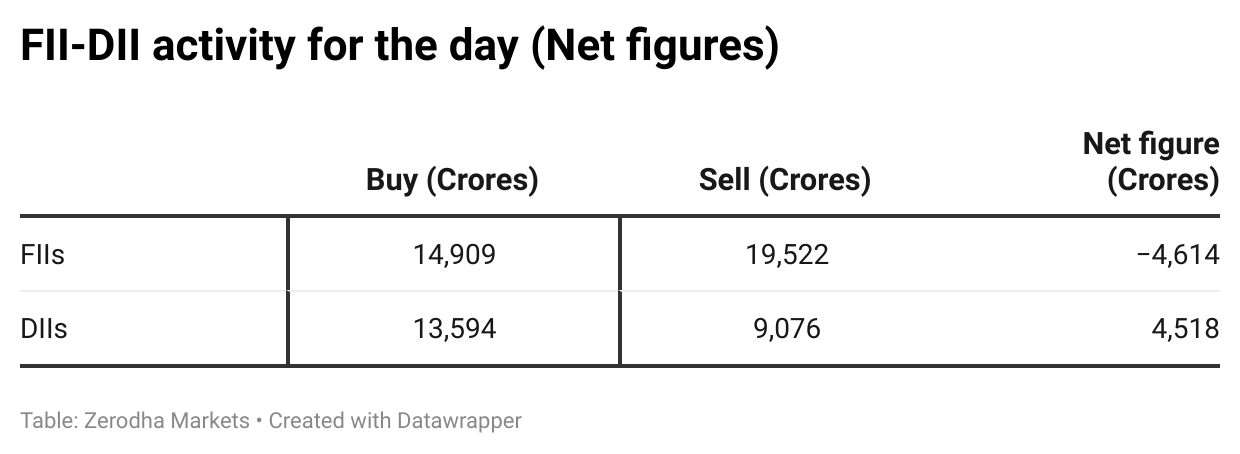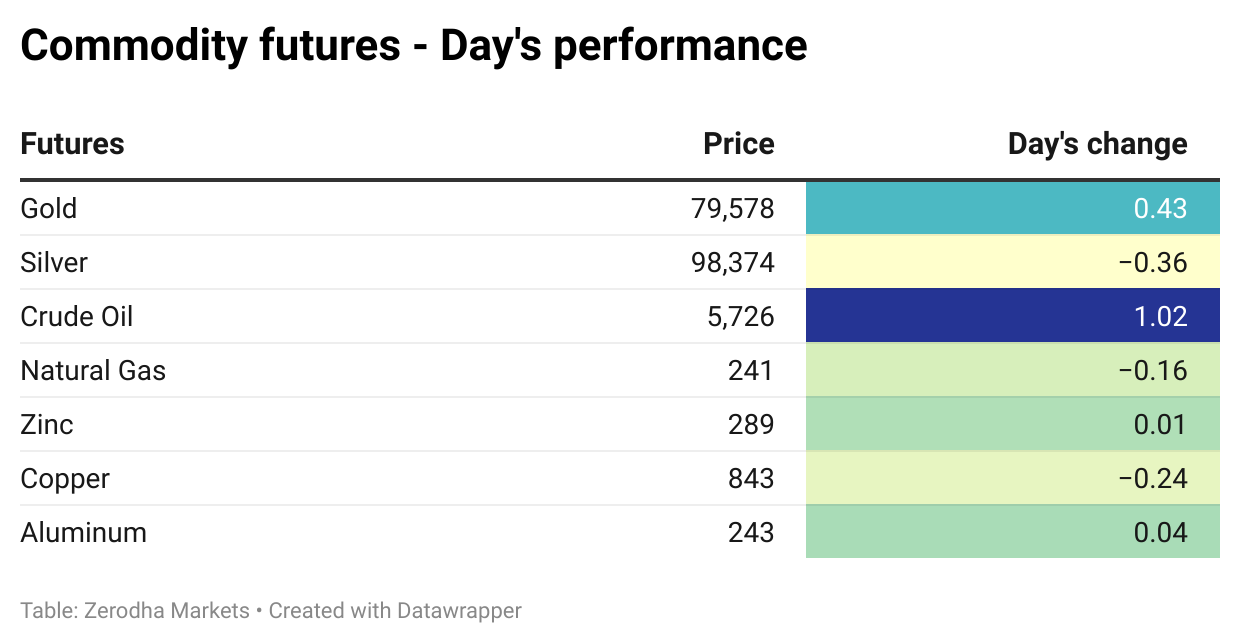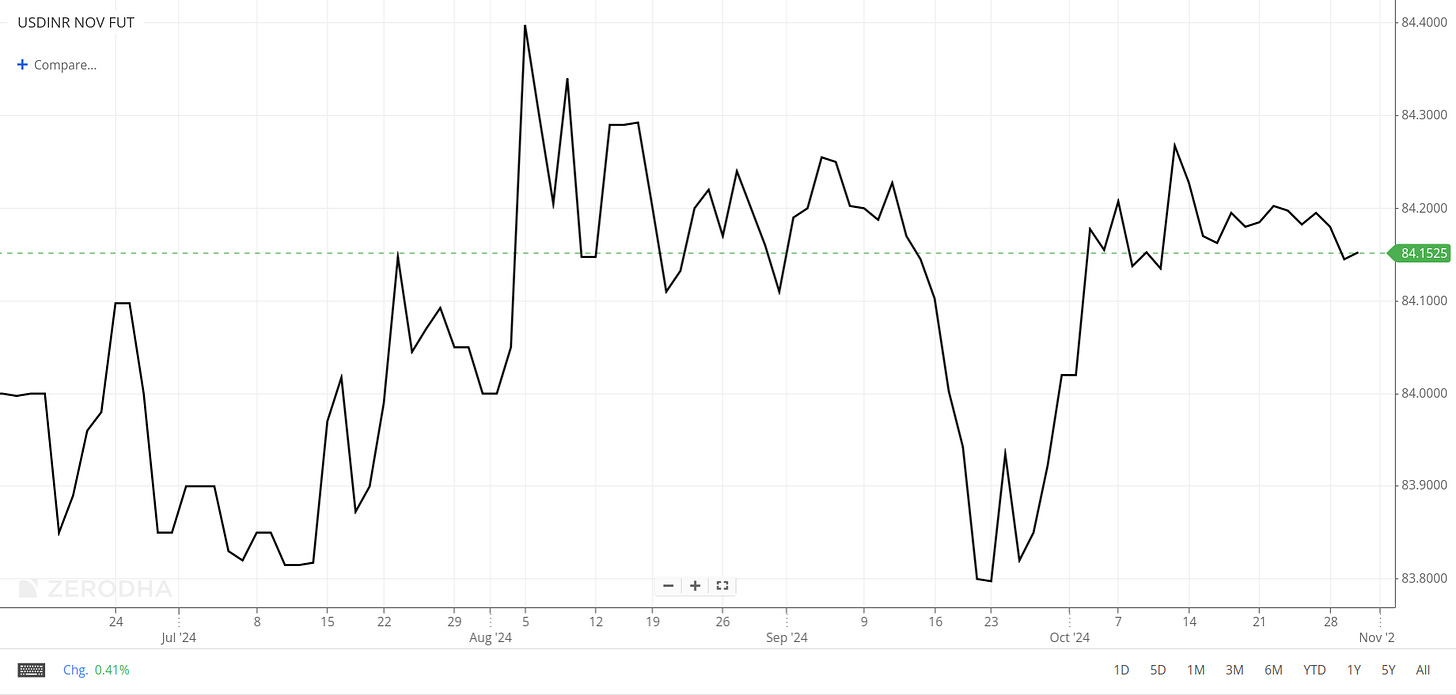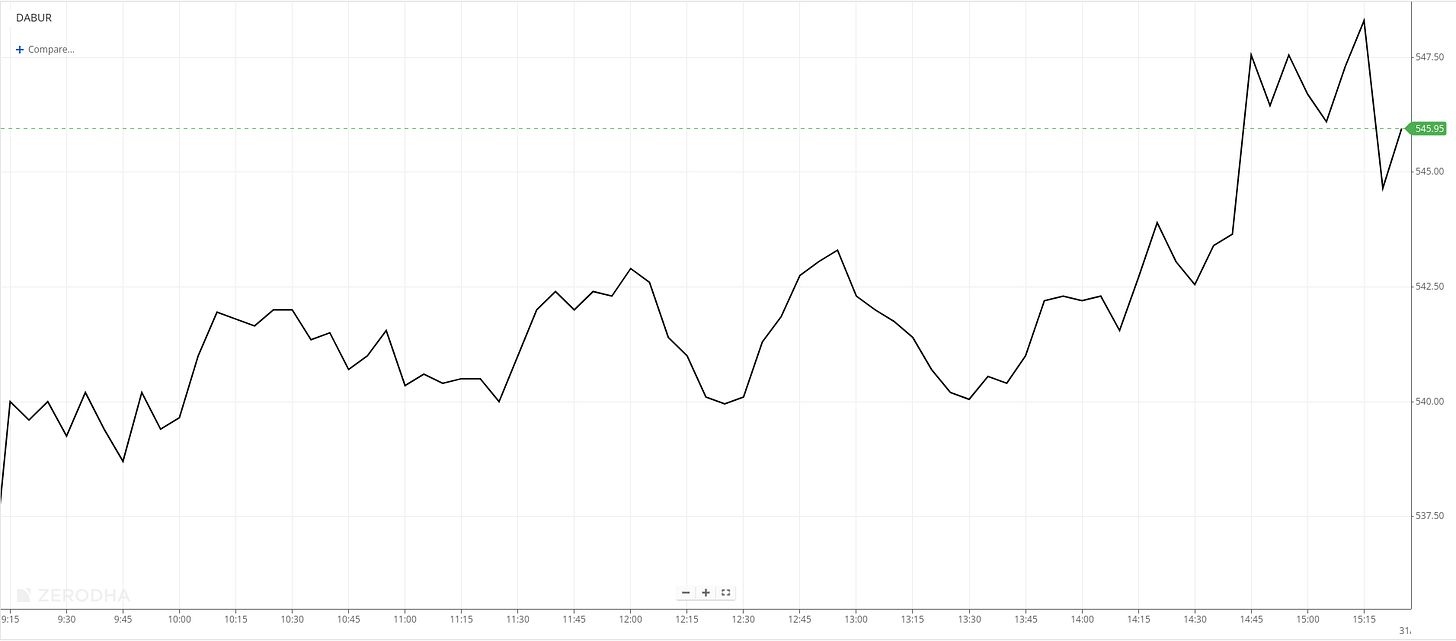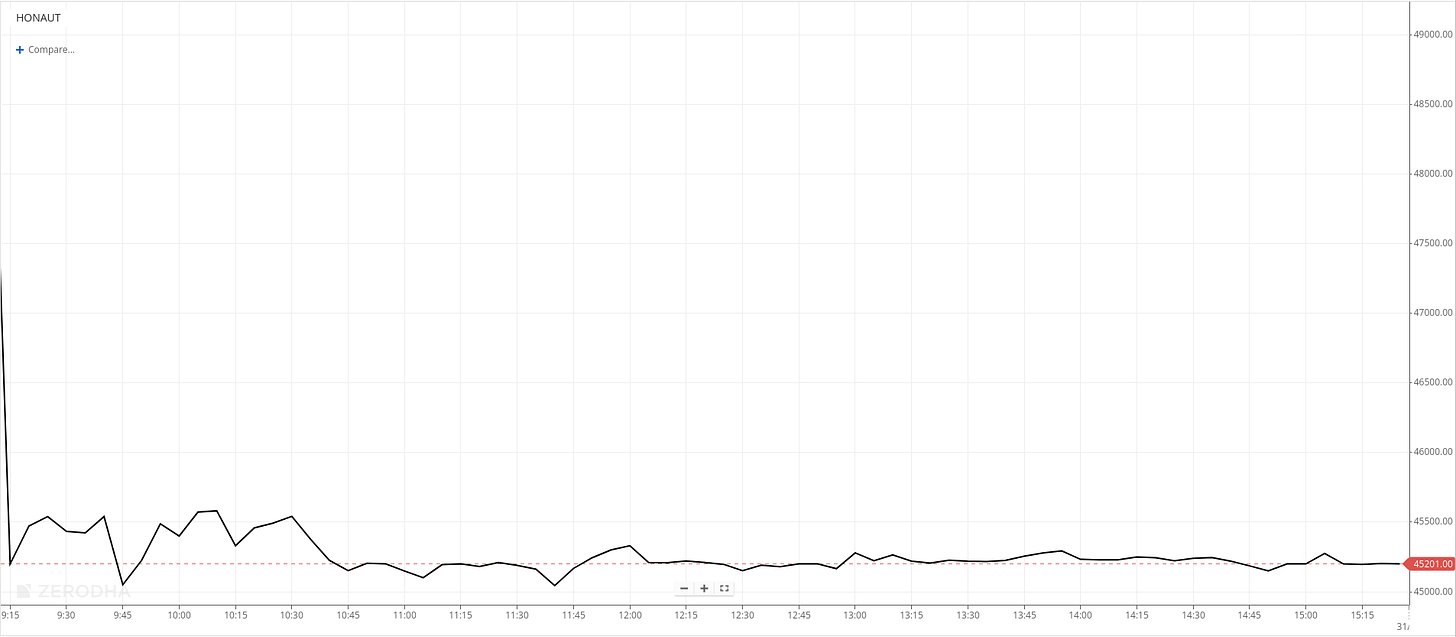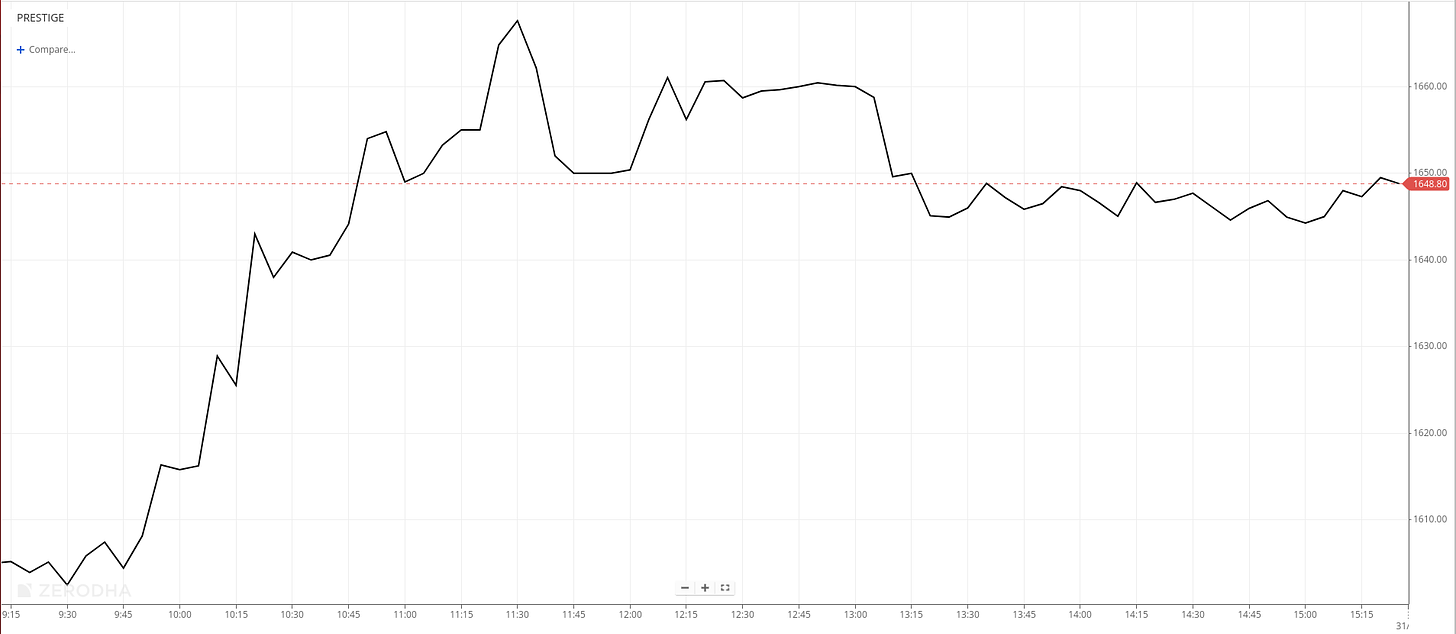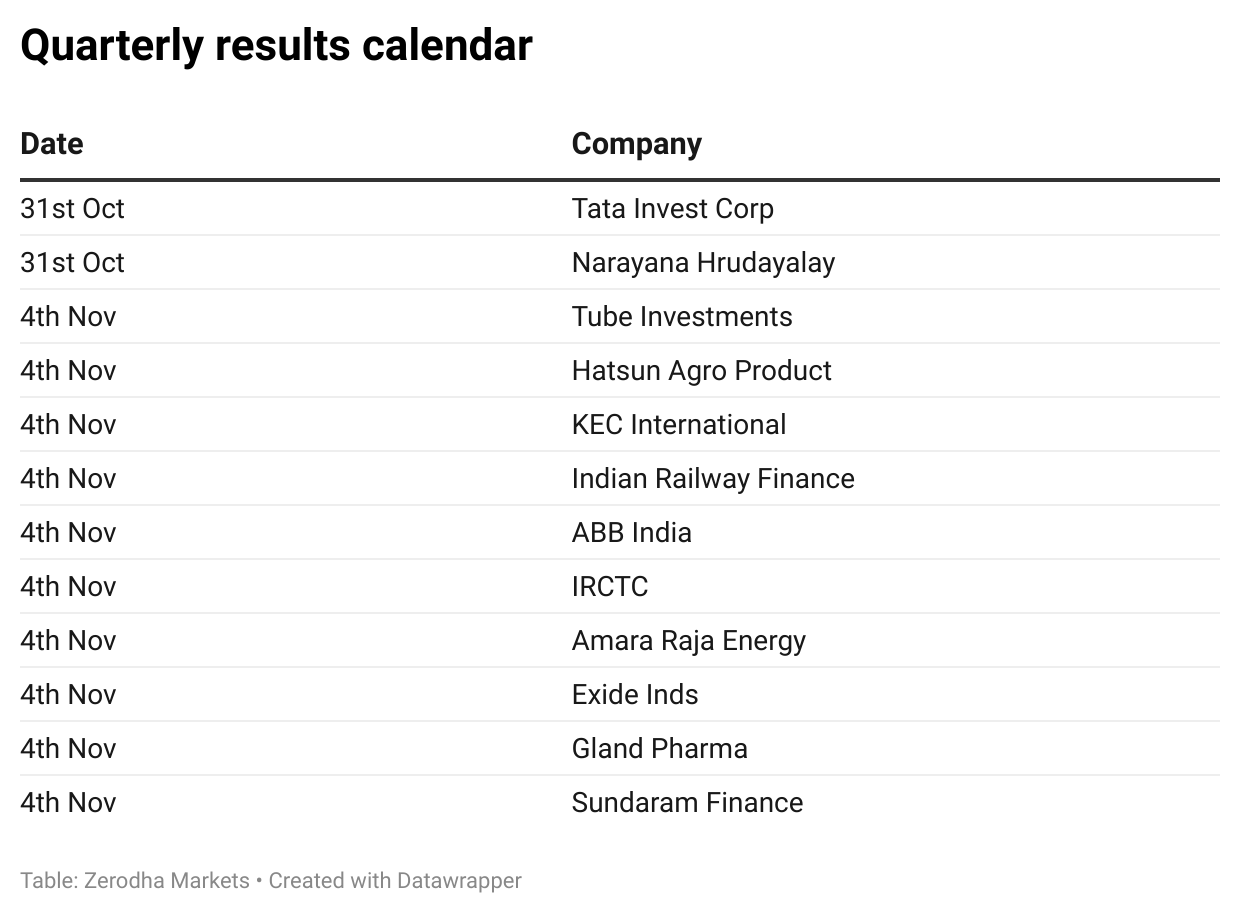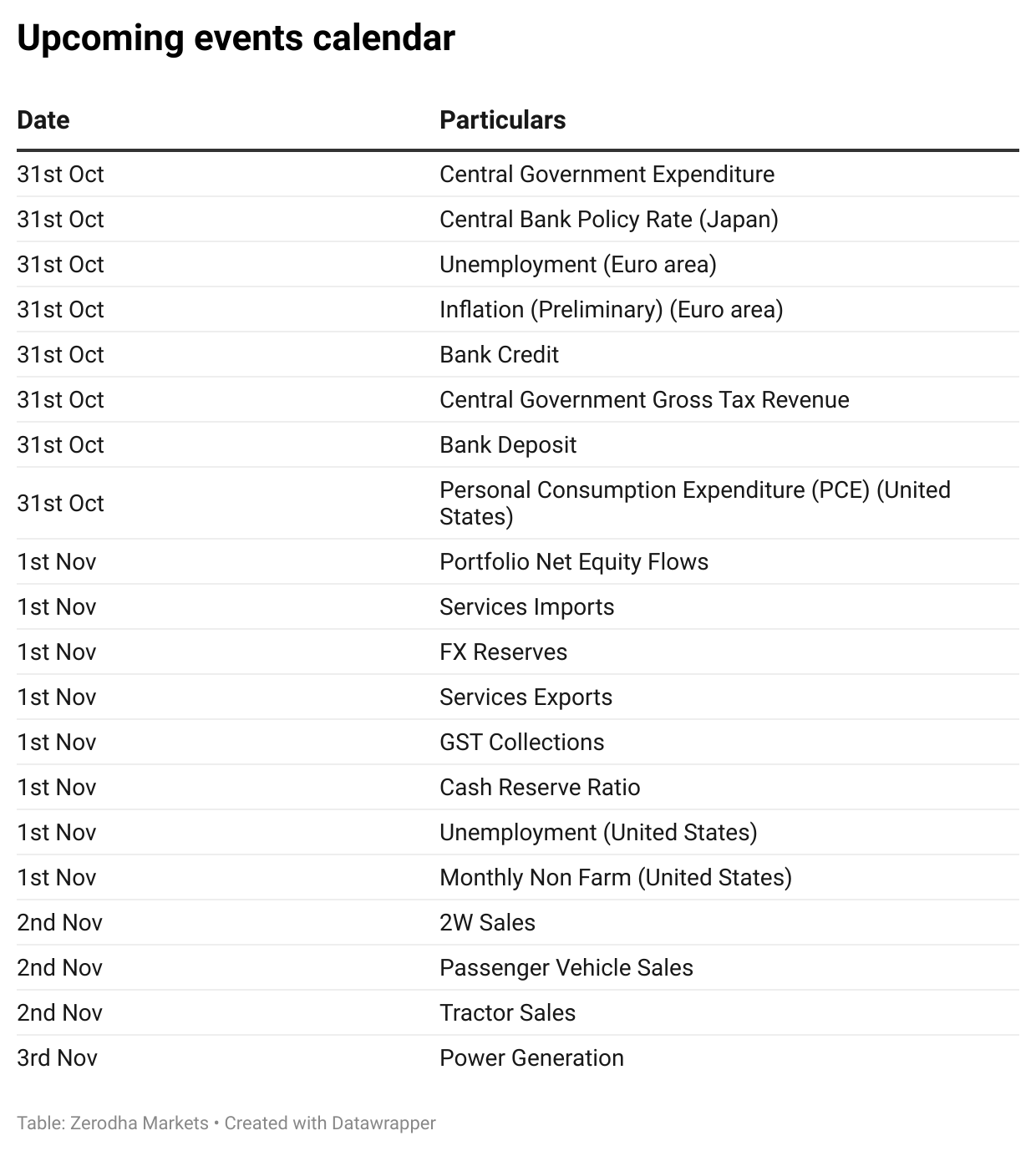On The Daily Brief , we do deep dives into 3-5 interesting stories of the day from the world of business and finance. However, not everyone has time to read long posts given their busy schedules, and just a quick wrap-up of what’s happened in the markets. This is what we want to do with the Aftermarket Report—a quick rundown of what’s happening in the markets to keep you updated.
We’re still experimenting with the format and what data points to cover. So, if you have any feedback, do let us know in the comments.
Nifty opened lower and, for the third consecutive day, tested the 24,480-24,500 range before reversing to close down at 24,350.30. While headline indices were weighed down by declines in pharma, banking, financial, and IT stocks, broader market sentiment remained positive, reflected in a strong advance-decline ratio of 3.05, indicating robust buying outside of these sectors.
Source: technicals.zerodha.com
Nifty Media and FMCG led the sectoral indices in gains, driven by strong earnings. Meanwhile, the Pharma, Banking, and IT sectors ended lower by nearly 0.85 - 1% each dragging the Nifty lower.
Source: Tijori Finance
Source: NSE
What’s happening in India
Adani Enterprises cancels plan to separate Adani Wilmar stake
What happened?
The company had announced in August that it would distribute shares of its FMCG arm, Adani Wilmar (AWL), to its shareholders. AWL is known for its Fortune brand cooking oil. However, the company has now decided not to proceed with this plan.
What does that mean?
Currently, Adani Wilmar holds a promoter shareholding of 87.9% and needs to meet the minimum public shareholding (MPS) requirement. SEBI mandates that all listed companies maintain at least 25% public ownership.
ISMA calls for sugar and ethanol price hike
What happened?
The Indian Sugar and Bio-Energy Manufacturers Association (ISMA) has formally requested that the government increase the minimum sale price (MSP) of sugar and ethanol for the upcoming 2024-2025 sugar season. ISMA proposes that the MSP of sugar be raised from ₹31 per kg, set in 2019, to ₹39.14 per kg. Additionally, they suggest increasing ethanol procurement prices to ₹73.14 per litre for ethanol from sugarcane, ₹67.70 per litre for B-heavy molasses, and ₹61.20 per litre for C-heavy molasses. ISMA also recommends permitting the export of 2 million tonnes (20 lakh tonnes) of sugar due to excess stock of approximately 3.12–3.22 million tonnes (31.21–32.21 lakh tonnes).
What does that mean?
ISMA’s request highlights the need for higher MSP and ethanol prices to support the industry’s economic viability amid increased production costs. The proposed export permission could help reduce the surplus stock, potentially stabilizing domestic prices and benefiting both manufacturers and farmers. The decisions by the government on these requests may impact both the sugar market and ethanol-based biofuel production in India.
Gold prices surge to record highs globally and in India, December futures hit ₹79,535
What happened?
Gold prices have reached new highs in India and globally, with December futures opening at ₹79,535 per 10 grams today, up by 0.38%.
Why?
- Festive Demand: Seasonal buying on Dhanteras and Diwali drives up gold demand.
- Global Economic Concerns: Ongoing geopolitical tensions and growth worries increase gold’s appeal as a safe investment in uncertain times.
- Weakening Currency and Inflation Hedge: Gold is a popular choice to protect against falling currency values and rising inflation, making it an attractive investment worldwide.
A new classification for blended aviation fuel
What happened?
The Indian government has reclassified blended aviation turbine fuel (ATF) as a separate category under the mineral items in the Central Excise Act. This move could pave the way for making blended ATF optional for domestic flights in 2025, with a mandatory target of 2027.
The Department of Revenue has set a 2% excise duty on blended ATF for flights under the Regional Connectivity Scheme (RCS) and UDAN, a government initiative to make air travel affordable and expand access across smaller cities. For all other uses, the excise duty is set at 11%.
Why this move?
Promoting Sustainability: This aligns with the goal to blend 1% sustainable aviation fuel (SAF) with jet fuel by 2027 to cut emissions, based on recommendations from the Ministry of Petroleum.
Industry Concerns: Airlines worry that high SAF production costs could increase fuel prices, potentially raising ticket costs in a price-sensitive market. They suggest government incentives to support voluntary adoption.
L&T secures multiple orders worth Rs 10,000 crore
What happened?
Larsen & Toubro Ltd. (L&T) announced that it has secured significant new orders, valued between Rs 5,000 and Rs 10,000 crore, within its power transmission and distribution segment. These orders focus on expanding and improving high-voltage electricity grids across the Middle East and Africa. Additionally, L&T, in partnership with an original equipment manufacturer, has won a contract to build Kenya’s National System Control Centre, a key facility for managing power distribution in the country. It is also set to announce its earnings for the September quarter today.
What does that mean?
The new contracts align with L&T’s strategy to strengthen infrastructure for electricity transmission in international markets and contribute to reliable power distribution. The Kenya project specifically aims to improve power flow management, integrate diverse power generation sources, and ensure efficient electricity dispatching, enhancing the stability and flexibility of the country’s power grid.
Indian Rupee hits record low amid global market volatility and foreign outflows
What happened?
The Indian rupee dropped to a historic low of 84.0900 against the U.S. dollar, surpassing its previous low of 84.0850. Concerns over U.S. election outcomes and ongoing foreign outflows from Indian equities have intensified pressures on the currency. Despite regular interventions by the Reserve Bank of India (RBI) to stabilize the rupee, it has depreciated by 0.34% this month. Additionally, regional currencies like the offshore Chinese yuan have also weakened, hitting a 2.5-month low, with the rupee’s volatility lower compared to the yuan. Foreign investors have withdrawn over $10 billion from Indian equities in October, a sharp reversal from the inflows seen in September.
What does that mean?
The rupee’s decline reflects heightened uncertainty in global markets, impacting foreign investor sentiment toward Indian assets. The RBI’s interventions have helped cushion the rupee somewhat, but ongoing foreign outflows underscore a cautious outlook by investors. If these trends persist, they could influence India’s trade dynamics, inflation, and broader economic conditions.
India urges IV fluid manufacturers to aid U.S. amid critical shortage after Hurricane Helene
What happened?
Following severe damage to a Baxter International facility caused by Hurricane Helene, the U.S. is experiencing a critical shortage of intravenous (IV) fluids, prompting the declaration of a national public health emergency. In response, the Pharmaceuticals Export Promotion Council of India, under guidance from the Embassy of India in Washington, has called on Indian manufacturers with FDA/EU/SRA approvals and sufficient capacity to help meet U.S. demand. Manufacturers interested in supplying IV fluids are encouraged to express their willingness.
What it means?
This appeal highlights a global health supply chain collaboration to address the IV fluid shortage, crucial for surgeries and other medical procedures in the U.S. The shortage has led to postponed medical procedures, and the FDA is actively authorizing imports from other countries to meet immediate needs. Indian pharmaceutical manufacturers could play a significant role in stabilizing the supply and supporting the U.S. healthcare system during this emergency.
What’s happening globally
EU imposes up to 35% tariffs on Chinese EVs, Beijing takes the matter to WTO
What happened?
The European Union has announced new tariffs on electric vehicles (EVs) imported from China. Chinese state-owned SAIC Motor and its subsidiaries will face a top tariff rate of 35.3%, while major Chinese EV makers BYD and Geely will face additional tariffs of 17% and 18.8%, respectively. Tesla, having negotiated with the EU, will incur a smaller tariff of 7.8%.
Why?
The EU imposed these tariffs due to concerns over alleged state subsidies that provide Chinese EV manufacturers with an unfair competitive advantage in the European market. After unsuccessful negotiations with Beijing, the EU moved forward with these tariffs to address these trade imbalances. China has objected and lodged a complaint with the WTO, increasing trade tensions between the two sides.
Germany Avoids Recession with Unexpected GDP Growth in Q3, Driven by Consumer Spending
What happened?
Germany’s economy grew by 0.2% in the third quarter of 2023, defying expectations of a 0.1% decline. This surprise growth, attributed to increased government and household spending, prevented Europe’s largest economy from slipping into a recession, which would have occurred with a second consecutive quarterly contraction. Revised data for Q2 shows a larger-than-reported 0.3% contraction. Economist Alexander Krueger noted that consumer spending played a crucial role in this rebound, despite underlying structural challenges.
What it means?
Germany’s modest growth offers temporary relief from recession concerns, although the economy continues to face hurdles like high energy costs, reduced global demand, and rising international competition leading to cost-cutting for many top companies. While consumer and government spending have provided a short-term boost, these challenges may limit Germany’s economic resilience in the near term.
Alphabet Surpasses Q3 Expectations with Strong Ad and Cloud Revenue Growth
What happened?
Alphabet, Google’s parent company, reported stronger-than-expected third-quarter results, with earnings reaching $2.12 per share and revenue totaling $88.27 billion, surpassing Wall Street estimates of $1.84 per share on $86.37 billion in revenue. The company’s core advertising revenue rose to $65.85 billion, up from $59.65 billion a year earlier, with YouTube ad revenue growing to $8.92 billion. Google Cloud also posted a 35% year-over-year increase, reaching $11.35 billion, exceeding analyst expectations.
What it means?
Alphabet’s Q3 performance eased concerns about competitive threats from AI in the search space, reaffirming the strength of its core ad business. The strong gains in YouTube and Google Cloud reflect Alphabet’s success in diversifying revenue sources, bolstering investor confidence. This robust growth prompted a 5% jump in Alphabet’s stock in premarket trading, signaling positive investor sentiment about Alphabet’s ability to innovate and expand in a competitive tech landscape.
Paris Olympics Boosts French Economy to 0.4% Q3 Growth, Beating Expectations
What happened?
France’s economy grew by 0.4% in the third quarter of 2024, exceeding analysts’ expectations of 0.3% growth and up from 0.2% in Q2. This stronger-than-anticipated growth was largely driven by a surge in consumer spending from tourists attending the Paris Olympic Games. The influx of visitors bolstered the economy, helping France, the eurozone’s second-largest economy, achieve a notable 0.5% rise in overall consumer spending.
What it means?
The positive economic impact of the Olympics highlights the role of large-scale events in boosting short-term economic activity, particularly through increased tourism and spending. This growth suggests that France’s economy is benefiting from temporary but significant boosts in hospitality, retail, and other consumer-driven sectors. While sustained growth may require broader economic measures, the Q3 performance reflects resilience and opportunities in the tourism and service industries.
Quarterly results
In this section, we’ll dive into all the key highlights from today’s intriguing results, covering the most impactful performances and standout moments. The numbers are comparable on a Year on Year (YoY) basis.
Dabur (+2.02%)
What Happened:
- Dabur’s Q2 net profit fell 17% YoY to ₹425 crore.
- Revenue declined 5% YoY to ₹3,029 crore.
- Declared an interim dividend of Rs. 2.75 per share, with a record date set for November 8.
Why?
- Lower consumer demand and reduced sales impacted earnings.
- Profit and margins were impacted by higher spending and reduced debt.
- Acquisition of a 51% stake in Sesa Care to expand in the Ayurvedic hair oil market.
Honeywell Automation India (-7.71%)
What Happened:
- Honeywell Automation India’s Q2 net profit fell 5.7% YoY to ₹115 crore, down from ₹122 crore in the same quarter last year.
- Revenue from operations dropped 7.3% to ₹1,024 crore, compared to ₹1,104 crore in the previous fiscal year.
- EBITDA decreased by 6.7% to ₹129.1 crore, down from ₹138.3 crore a year earlier.
Why?
- Slowing industrial demand led to lower revenue and profit for the quarter.
- Higher material costs affected profits, though margins improved slightly.
- External factors, like increased shipping costs from the Red Sea crisis, further impacted overall earnings.
Prestige Estates Projects (2.74%)
What Happened:
- The company reported a 77.41% YoY drop in net profit to ₹192.20 crore.
- Revenue from operations rose 3.04% YoY to ₹2,304.40 crore.
- EBITDA fell 53.43% YoY to ₹750.7 crore, with a margin of 30.97%.
Why?
- Reduced pre-sales volume, down 43.3% YoY, impacted revenue growth.
- ₹106 crore deferred tax expense from removal of indexation benefits on capital gains.
- Lower sales volume of 3 million sq. ft. versus 6.84 million sq. ft. last year.
- Rising input costs contributed to the decline in profits.
In the coming days, We have the following quarterly results and other major events:
Source: Economic Calendar by Zerodha
That’s it from us. Do let us know your feedback in the comments and share it with your friends to spread the word. ![]()

